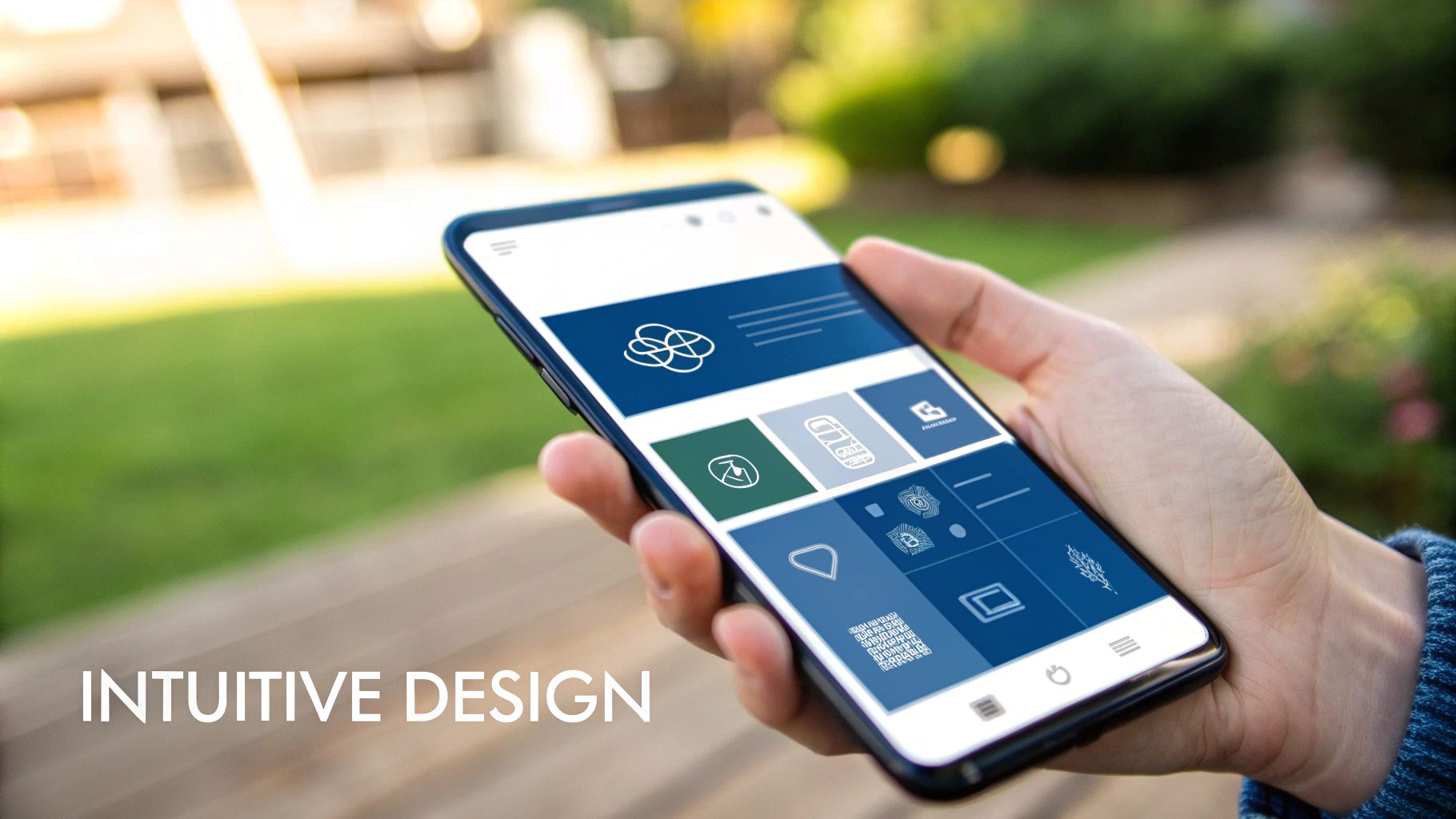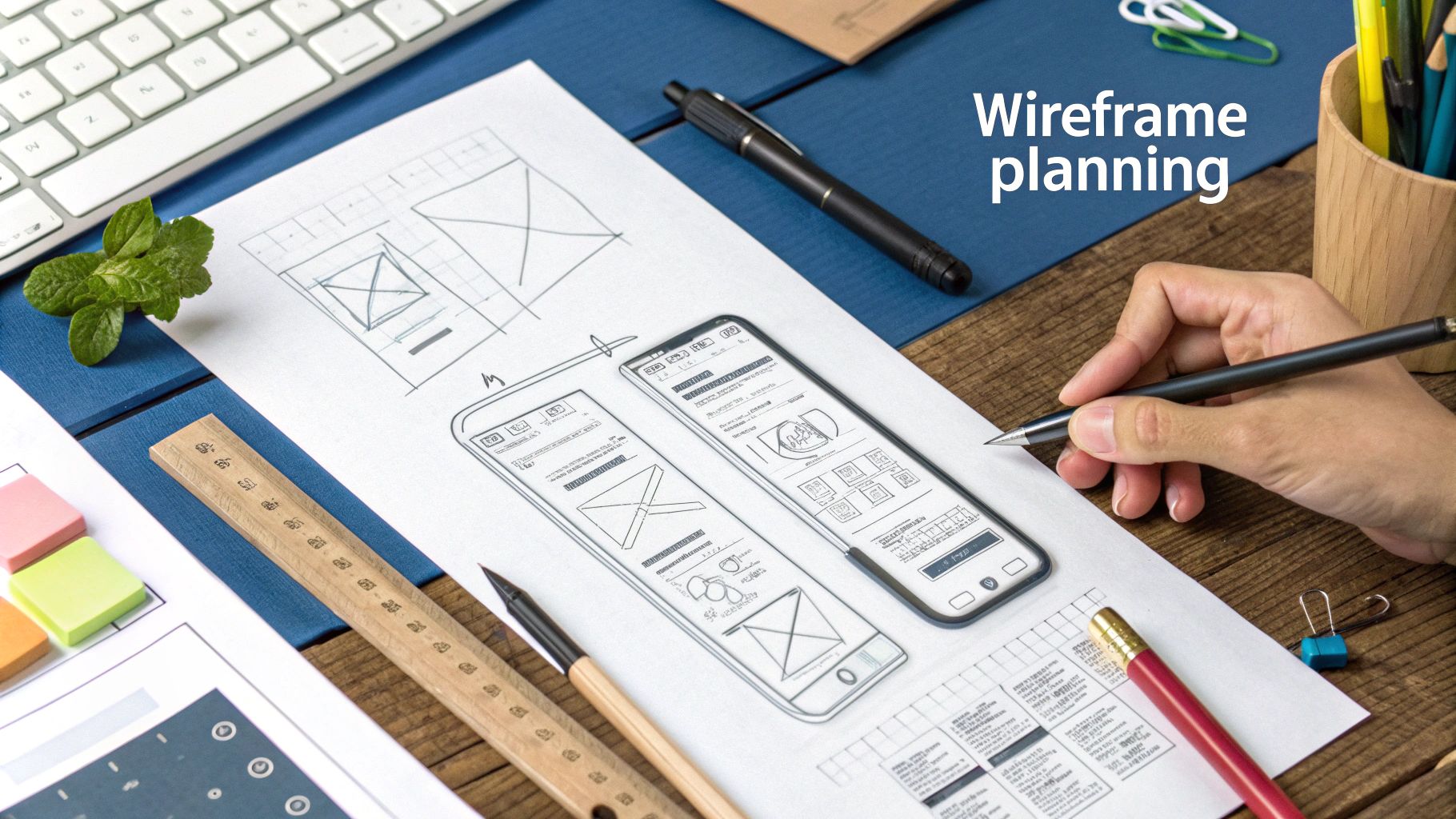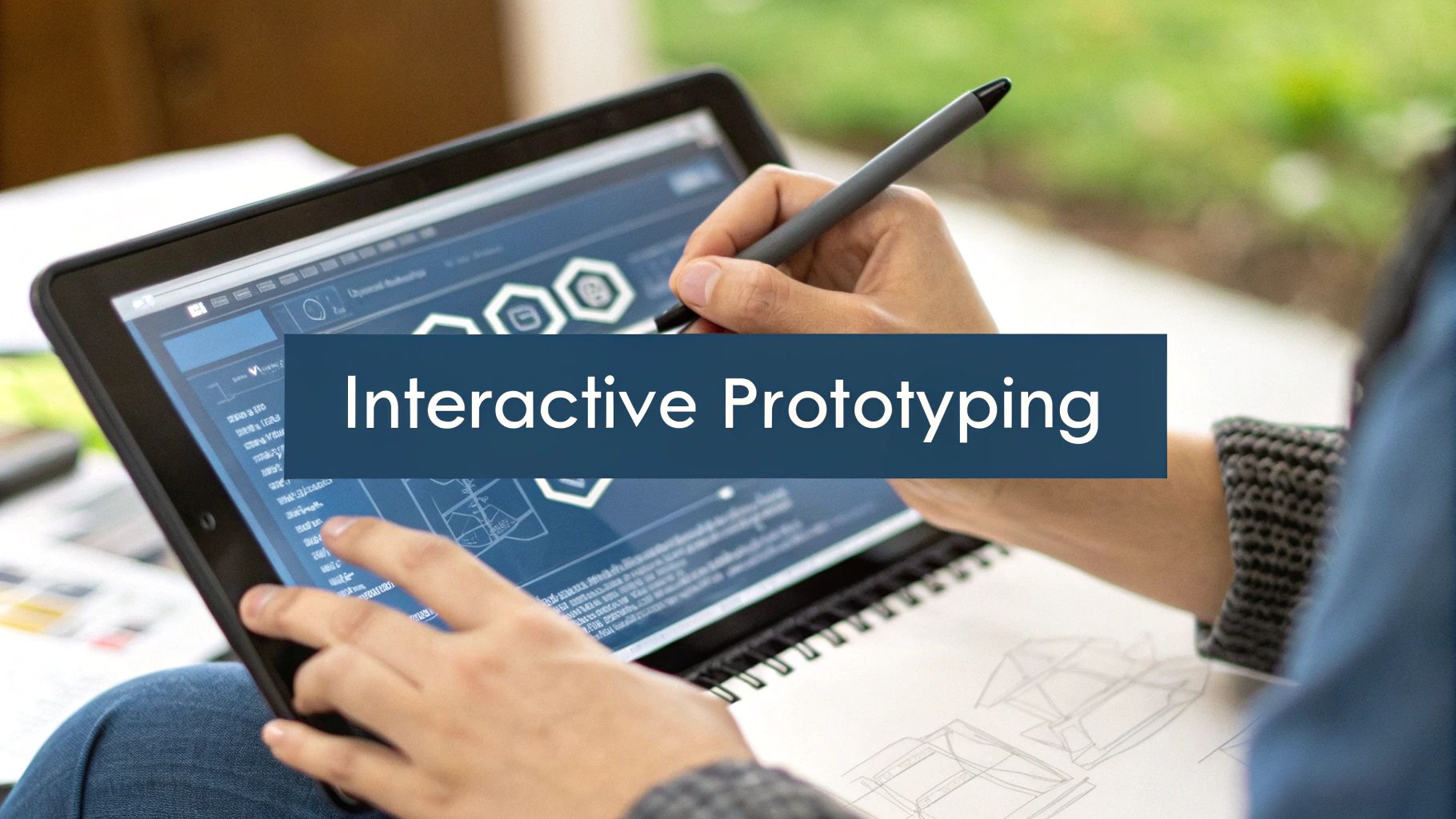The Ultimate User Experience Design Playbook: Strategies That Actually Work
"
Breaking Down the Real Business Impact of UX
Great user experience (UX) design directly affects a company's bottom line. When businesses invest in creating seamless, enjoyable experiences that truly serve user needs, they can see returns of up to 400% on their UX investments. This isn't just about making things look nice – it's about designing products and services that solve real problems and keep customers coming back.
The Correlation Between UX and Key Business Metrics
Poor UX costs companies real money through lost sales and customers. For instance, when visitors land on a confusing website, they quickly leave – leading to high bounce rates that hurt search rankings and conversions. But when users can easily navigate a site and find what they need, they stick around longer and are more likely to take desired actions like making purchases or signing up for newsletters.
The numbers tell the story: 68% of users have stopped using a brand simply because they felt the company didn't care about their experience. This shows how UX directly impacts customer retention and loyalty. When businesses take time to understand and design for their users' needs, they build stronger relationships that translate into long-term value. Happy customers also tend to recommend brands to others, creating a ripple effect of organic growth through word-of-mouth.
Real-World Examples of UX Driving Success
Let's look at how UX improvements deliver real results. One company completely redesigned their website to simplify navigation and optimize for mobile devices after seeing high bounce rates and low conversions. The result? A dramatic increase in both engagement and sales. Similarly, a mobile app maker was struggling to keep users active. By doing careful research to identify pain points and create more intuitive flows, they significantly boosted both retention and daily usage.
Measuring and Communicating the Value of UX
To get buy-in for UX investments, teams need to show concrete results. Key metrics like conversion rates, bounce rates, task completion times, and customer satisfaction scores help quantify UX impact. This data builds the business case for ongoing UX work.
It's also crucial to connect UX efforts to overall company goals. By showing how good design drives customer satisfaction, loyalty and revenue, UX teams can get broader organizational support. The evidence is clear – investing in UX isn't optional for businesses that want to grow and succeed against competitors.
Understanding the Human Side of UX Design
At its core, great UX design starts with understanding how people think and behave. While visual appeal matters, the real power of UX comes from creating digital experiences that feel natural and effortless to users. This means applying key psychological principles to guide design decisions.
The Psychology Behind Effective UX Design
Have you ever wondered why some apps and websites just "click" while others leave you scratching your head? The secret lies in how well the design matches the way our brains process information. Take the concept of "chunking" – our minds naturally group related items together. That's why phone numbers are split into smaller chunks instead of one long string of digits. Smart UX designers use this principle by organizing content with clear headings, bullet points, and short paragraphs that are easy to scan and understand. They also guide users' attention through thoughtful visual hierarchy, using larger fonts and contrasting colors to highlight what's most important.
Emotional Connections and User Decisions
Good UX isn't just about making things work smoothly – it's about making users feel good about the experience. For example, a friendly onboarding process that walks new users through key features helps build trust and confidence. On the flip hand, a confusing or frustrating experience can quickly send users running. Understanding what motivates users' choices is also key. Simple elements like customer reviews, limited-time offers, and expert recommendations can subtly influence decisions while still feeling natural and helpful rather than pushy.
Practical Techniques for User Research
Getting to know your users doesn't have to be complicated or expensive. Simple methods can reveal valuable insights about what users need and expect. Sitting down for conversations with even a small group of users can uncover pain points and opportunities you might have missed. Running A/B tests lets you compare different design options to see what actually works better. And sometimes the best insights come from simply watching people use your product or similar ones in real life. This hands-on research helps ensure the final design truly serves users' needs rather than just looking good on paper.
Advanced Technology and UX Design
Technology shapes how users interact with digital products. This section explores how Artificial Intelligence (AI) and Augmented Reality (AR) are changing what's possible in UX design. We'll focus on practical ways designers can use these tools to create better experiences, with clear examples of what works and what doesn't.
Making the Most of AI in UX Design
AI opens up new ways to personalize and simplify user experiences. Take online shopping – AI can study what products someone typically buys and browse, then suggest items they're likely to want. This makes shopping easier and more enjoyable. For designers, AI takes over repetitive tasks like creating design variations or analyzing user data. This frees up time to focus on bigger creative challenges and strategic thinking that machines can't handle.
Bringing AR into User Experience
AR adds digital elements to the real world, creating new possibilities for interaction. For instance, furniture retailers now let shoppers see how a couch would look in their actual living room through their phone's camera. This hands-on preview helps customers feel more confident about purchases. AR also works well for interactive help guides and training – users can see step-by-step instructions overlaid on real objects, making complex tasks easier to understand.
Smart Choices About New Technology
Just because a technology is new doesn't mean it's right for your project. Good UX design starts with asking "Will this actually help users?" rather than chasing trends. New tools should solve real problems without making things more complicated. The best approach is starting small – test new technologies with a pilot project, gather feedback, and expand what works. This careful method helps avoid wasting time and resources on flashy but unhelpful features.
Looking at Results and User Response
Tracking how users respond to new technology is essential. Standard metrics like task completion time and error rates still matter. But also look at specific measures for each tool – if you add AI recommendations, check if they lead to more sales and engagement. Regular testing shows if changes actually improve the experience. Bad UX can frustrate users and hurt business results. By putting users first and choosing technology thoughtfully, designers can create experiences that work better for everyone while helping businesses succeed.
Building User-First Design Processes That Scale
Growing from a startup to a larger company brings exciting opportunities, but it also creates unique challenges for maintaining great user experiences. When you scale up your design processes, the key is finding ways to stay deeply connected to your users while operating more efficiently. Let's explore practical approaches that help teams deliver excellent user experiences even as they expand.
Integrating User Feedback Throughout the Design Process
Just like you wouldn't build a house without checking in with the future homeowner regularly, good design requires constant user input. The most successful teams make user research a core part of every stage – from testing early concepts to evaluating working prototypes. Getting feedback early helps catch problems when they're still easy to fix. For instance, showing users paper prototypes can reveal major usability issues before investing in development. This ongoing back-and-forth creates a genuine partnership with users who feel heard and valued.
Managing Stakeholder Expectations While Scaling
As your company grows, more people naturally become involved in design decisions. Product managers, executives, engineers and others all bring different priorities to the table. The key is showing stakeholders concrete evidence of how good UX directly impacts business results. For example, walk them through case studies where improved usability led to higher sales or fewer support tickets. Regular updates on user research findings help keep everyone aligned around putting users first. Clear communication builds the trust needed for stakeholders to support user-centered decisions.
Maintaining Design Quality at Scale
When design teams expand and start working with outside partners, keeping a consistent experience becomes harder. It's similar to how restaurant chains need strict standards to ensure every location delivers the same quality. Design systems serve this purpose in UX by providing shared components, patterns and guidelines that teams can reliably reuse. When done right, users get the same polished experience whether they're on your website, mobile app or other touchpoints. The design system acts as a foundation that helps teams work efficiently while maintaining high standards.
Practical Frameworks for Scalable UX
Several proven approaches can help structure growing design teams for success. Start by clearly defining who owns different parts of the process – this creates accountability and prevents important work from falling through the cracks. Many teams also benefit from running focused design sprints to quickly solve specific user problems and test solutions. The goal isn't just to do more design work, but to work smarter. With the right frameworks in place, teams can efficiently deliver great experiences that truly improve users' lives. When executed well, this focus on users leads to more loyal customers and better business results. At its core, caring about users is both the right thing to do and the path to sustainable growth.
Measuring What Actually Matters in UX
Creating exceptional user experiences requires a data-driven approach rather than pure intuition. Instead of fixating on basic statistics like page views, successful UX design focuses on metrics that reveal how people actually engage with your product and how that impacts business outcomes. This targeted measurement helps align design decisions with real user needs and company goals.
Identifying Key UX Metrics
While the most relevant metrics depend on your specific objectives, several key measurements can provide valuable insights:
-
Task Completion Rate: When users successfully finish important actions like purchases or form submissions, it signals good usability. Low completion rates point to friction points that need fixing.
-
Error Rate: By tracking where users make mistakes – like form errors or failed logins – you can spot problems in your design. This helps identify exactly where improvements are needed.
-
Time on Task: Looking at how long users spend completing specific actions gives insight into efficiency. While faster is usually better, extremely quick times might mean users are giving up partway through.
-
System Usability Scale (SUS): This proven questionnaire method measures how usable people find your product. Higher SUS scores typically indicate better overall experiences.
-
Customer Satisfaction (CSAT) Score: Simple survey feedback on specific features helps gauge user happiness and highlights what needs work.
Gathering Meaningful User Feedback
Numbers tell only part of the story. To truly understand user behavior, you need qualitative insights:
-
User Interviews: One-on-one conversations reveal deep insights about what motivates users and what frustrates them. This direct feedback is invaluable for improving designs.
-
Usability Testing: Watching real people use your product shows exactly where they get stuck or confused. This hands-on observation helps identify and fix UX problems.
-
Surveys: While less detailed than interviews, surveys efficiently collect feedback from many users about specific features. This broader input helps prioritize improvements.
For instance, an online store might see declining sales in their data. But through user interviews, they discover customers find the checkout confusing – giving clear direction for fixing the issue.
Translating Data Into Actionable Insights
Collecting data is just the start. The real value comes from turning those findings into improvements:
-
Prioritizing Issues: Focus first on fixing the problems that most affect key metrics and user satisfaction.
-
Iterative Design: UX design works best as an ongoing cycle – make changes, test with users, and keep refining based on what you learn.
-
Communicating Findings: Share data and insights with team members to build support for UX improvements and ensure everyone understands user needs.
When you measure what truly matters in UX, gather meaningful feedback, and act on those insights, you create products people genuinely want to use. Research shows that 48% of visitors consider website design the main factor in judging brand credibility. Good UX isn't just about looks – it directly impacts your brand's reputation and success.
Future-Proofing Your UX Strategy
User experience design constantly evolves as technology and user needs change. Companies need to develop UX strategies that can adapt and grow over time while continuing to serve users effectively. Let's explore practical approaches to creating a UX strategy built to last, with a focus on adaptability and smart design choices.
Embracing Emerging Technologies in UX Design
New technologies open up exciting possibilities for improving user experiences. For instance, many online retailers now use augmented reality to help shoppers visualize products in their homes before buying. But adding new tech requires careful thought. The key is choosing technologies that genuinely make things easier for users, not just adding features for the sake of it. Take AI personalization – it should help users find what they want more quickly, not overwhelm them with endless recommendations.
Designing for the Future User
User preferences and behaviors shift as technology advances and society changes. To stay relevant, UX teams need to actively study emerging user needs through ongoing research. This means regularly talking to users, analyzing behavior patterns, and watching for new trends. Voice interfaces provide a good example – as more people use voice commands, designers must understand how to create natural voice interactions that feel intuitive and helpful.
Building Scalable and Adaptable Design Systems
A well-planned design system acts as the foundation for consistent user experiences as products grow. Think of it as a collection of reusable design elements and guidelines that teams can draw from. This ensures users have a smooth experience across different parts of your product while giving designers flexibility to iterate and improve. As your product lineup expands, having this systematic approach becomes even more valuable for maintaining quality at scale.
Fostering a Culture of Innovation in UX
Creating future-ready user experiences requires an environment where UX teams feel empowered to experiment and learn. Regular design sprints and creative workshops give designers space to test new ideas and approaches. Recent studies show that 94% of negative user feedback relates to design issues, highlighting why continuous improvement matters. When teams have the freedom to try new solutions while learning from user feedback, they can build experiences that stay fresh and relevant over time.
Want to delve deeper into optimizing your website's performance and enhancing user experience? Check out DebugBar, a comprehensive news platform covering technology, digital trends, and marketing. It's a valuable resource for staying informed about the latest tools and strategies to improve your website's performance and user experience.




Comments
Leave a comment